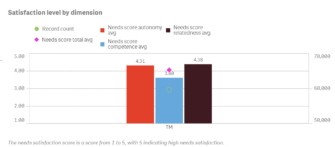How to Know If Your TM or F2F Sustainer Acquisition Meets Donor Needs
Over forty years of research and theory show people have three basic, psychological needs. Satisfying these needs makes donors more likely to stick around.
The three are:
- Competence – feelings of effectiveness. For donors, it could mean feeling like they’re making a positive difference. It could also mean learning something new, for example, information about the problem your charity is trying to solve.
- Relatedness – feelings of being connected and having a sense of belonging with others. Giving and contributing to others is one way people to satisfy their need for relatedness. But how much relatedness donors will actually experience depends on how well your campaigns can foster a meaningful sense of connection between them and both the people receiving their support and your charity. Touchpoints that are plainly role-bound, transactional, and empty of interpersonal salience are not likely to promote a sense of relatedness.
- Autonomy – feelings of willingness and volition. For donors, this first and foremost means not feeling guilted or otherwise pressured or into giving. Providing a convincing rationale, along with meaningful options for choosing how to give support are ways to increase donor autonomy satisfaction.
How do you measure these? We have a proprietary set of six questions (2 per need) to measure these after a F2F or TM interaction. As an example, here’s one of the six– this one measuring Relatedness– “The fundraiser was friendly”. These are all measured on a five point, fully labeled scale.
The screen shots below are from a platform that pulls in data from the TM agency and/or F2F agency combined with retention/payment data from the client and all this rich, zero-party data, some of which is collected at signup (think Census, not sample, such as Identity and Commitment) and some, like need satisfaction, collected after the signup. This need satisfaction measurement is done via SMS, email or even over the phone if you’re doing a welcome call, for example, for newly acquired canvass donors.

By assessing the multidimensional facets of “satisfaction” we’re better able to tailor the follow-up email we send that is responsive to the need satisfaction scores for each donor.
For example:
- Donors feeling ineffectual or hopeless in promoting a human rights outcome (low competence) after a telemarketing or canvassing interaction (and despite saying “yes” to the ask) means these specific donors need enhanced feedback about how their gifts are making a positive difference. But send that enhanced feedback to those with high competence and you risk violating the “show me you know me” maxim of good donor communication.
- Donors feeling unduly pressured or guilted into giving by a pushy canvasser (low autonomy) means those donors (and only those) would benefit from a non-pressurized, “save call” designed to provide more rationale for your charity and their choice.
- Donors feeling unappreciated and taken for granted (low relatedness) warrants an apology to mitigate the negative interaction but only for whose relatedness needs were thwarted.
There is a very strong relationship between need satisfaction scores and retention. This screenshot shows a prediction model for 90-day retention broken out by need satisfaction data. The group at low risk of quitting in the first 90 days were much more psychologically satisfied with the telemarketing call than the high risk group.

But this isn’t just about measuring and acting on donor level data that improves the donor experience. It is about linking this data back to the telemarketers and/or canvassers to help with training, remediation and eventually, remuneration. Do you really want to pay telemarketers based on output and not, at least partially, on the quality of that output?
Here you see need satisfaction data linked back to the telemarketers. We’ve anonymized but the data is real. I see that on this most recent week of calling Telemarketer 456 is signing up more people than Telemarketer 123 per the height of the (tiny) green circle. However, we know with high, high certainty that the retention for those sign-ups will be markedly worse because the donors’ psychological needs are not being as well-met.
If you’re going to fix your leaky bucket you need to solve the problem of the “hand” that is pouring the water. This approach does that in a real-time, productive, positive way. I don’t want to fire TM_456. She is new and doing “well” by one measure, volume. But, that is one-hand clapping. There is specific training to help address the way she helps the donor feel more competent and autonomous (her two biggest weaknesses in her pitch and approach).

Donor-experience matters but not as a platitude or soft-fuzzy concept or a subjective one. To get past that,
- Define donor experience
- Measure it
- Make sure those measures predict outcomes
- Make it a standard, on-going business process, not a one-off
- Be very clear you know exactly how you are going to use the data to change outcomes before you start #1
Kevin



I don’t mean to be Grinchy, but we talk and talk and talk about subject lines…
Can we please take our own advice?
Thanks!
Cindy, not sure what you’re referencing, can you be more specific?
I can’t read minds, but possibly Cindy means that “TM” could mean Transcendental Meditation, or a number of other things. This is the first time I’ve seen it used for “telemarketing,” and you never explained the term: I inferred the meaning about five paragraphs in.